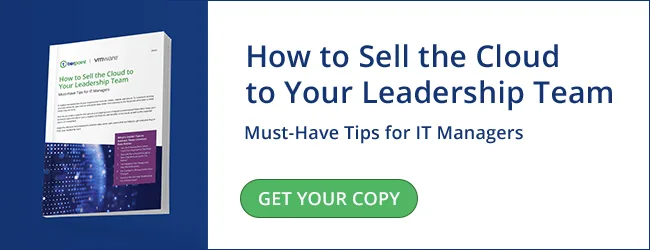
The components that contribute to IT costs have changed significantly over time. What was once dominated by on-premises hardware and dedicated servers has evolved into a multi-layered landscape with virtual machines, containers, and cloud environments. Cloud migration can come with both operational and financial benefits, allowing businesses to innovate more efficiently, scale more smoothly, and integrate systems with greater ease, but the initial investment of a cloud migration can be something leaders are hesitant to sign off on. Being able to calculate and convey the return on investment (ROI) of the cloud can help IT leaders justify cloud migration to key stakeholders. Let’s explore what cloud ROI is, how to calculate it, and how to sell it to leadership to allow for more innovation and growth.
What is Cloud ROI and Why Should You Measure it?
Cloud ROI measures the value a company gains—through cost savings, revenue growth, and operational efficiencies—relative to the total investment made in cloud adoption and ongoing usage.
While moving to the cloud can include an upfront investment, cloud ROI demonstrates how the investment will generate returns over time. For example, pay-as-you-go pricing models means that organizations are only paying for the resources they’re using. The integrations possible in cloud environments can mean businesses are saving time by cutting down on manual tasks. Cloud infrastructure is designed to handle emerging technologies, allowing businesses to innovate, gain a competitive edge, and win over more customers. Some of these benefits can be immediate, while others will take longer to come to fruition. It’s important to measure short-term and long-term gains to truly calculate cloud ROI.
Measuring Cloud ROI – How is it Calculated?
That being said, it’s easier said than done to measure cloud ROI. The general formula to calculate cloud ROI is as follows:
(Financial benefits from cloud – Cost of the cloud infrastructure) / Cost of the cloud infrastructure = Cloud ROI
Financial benefits from the cloud could include:
- Cost savings from reducing manual tasks
- Value of new customers / clients gained
- Reduced costs when shifting from a CapEx (capital expenditures) to an OpEx (operating expenditures) model
- Cost savings switching from legacy frameworks to SaaS tools and pay-as-you-go cloud resources
- Cloud service provider fees that are lower than data center costs (hardware maintenance, energy costs, personnel, etc.)
Costs associated with the cloud infrastructure can include:
- Costs to work with a cloud provider for resources (pay-as-you-go, reserved instances, spot instances)
- Specialists to help with cloud migration
- Network infrastructure, storage, maintenance costs
- Overages associated with exceeding fixed data limits
It can be difficult to get an accurate calculation of cloud ROI when there are so many parts that may be added and removed during a cloud migration process. However, the basic calculation involves starting with the total cost of ownership (TCO) for moving to the cloud and acknowledging savings earned from equipment, facilities, and components that are no longer needed.
Once gains have been identified, they can be compared to any costs and plugged into the formula for the cloud ROI.
For example, if a business spends $50,000 per year on cloud infrastructure, spends $50,000 on the initial setup and cloud migration, saves $80,000 on annual costs associated with running a data center, saves $10,000 on personnel costs with more efficient processes, and gets new clients that bring in $100,000 annually, the costs would be $100,000, while the gains would equal $190,000. Thus, the ROI for the first year would be:
(Financial benefits from cloud – Cost of the cloud infrastructure) / Cost of the cloud infrastructure = Cloud ROI
($190,000 – $100,000) / $100,000 = 90%
This would spell a very strong cloud ROI for businesses. It’s important to note that the ROI may not be positive immediately due to the total cost of ownership included in the investment. Making the initial switch can take a lot of time, require outside skills, and require a calculation of operating expenditures (OpEx) versus capital expenditures (CapEx).
Common Challenges in Measuring Cloud ROI
We’ve already mentioned that calculating cloud ROI can be a complicated endeavor, and this is due to a combination of complex cloud pricing, a need to quantify intangible benefits, and difficulty aligning business objectives with cloud investments.
Also remember, ROI may not account for opportunity costs or intangible benefits—factors that are particularly important in digital transformation initiatives.
Complex Cloud Pricing and Billing Models
Businesses typically pay a set price for the predictable cloud resources they know they’ll always need, supplementing that with pay-as-you-go pricing for additional resources and purchasing spot instances for testing or other environments that don’t require as much reliability and availability. This can make it seem straightforward, but monthly and annual licenses can come with hidden fees for going over set limits.
Understanding how each cloud structure works, and which instances are right for which workloads, will make cloud pricing feel less complex.
Quantification of Intangible Benefits
While you will be able to quantify much of the savings about cloud migration, certain benefits are intangible or much harder to measure, such as increased agility or improved collaboration. You may be able to quantify this over time by looking at productivity levels and output before and after cloud implementation, but capturing this information can be more difficult.
Alignment of Business Objectives and Cloud Investments
Cloud computing is now a normal part of business operations for many organizations – according to Flexera’s 2025 State of the Cloud, more than half of all SMB and enterprise workloads run in the public cloud, like Amazon Web Services (AWS) or Microsoft Azure. However, your business’s investment shouldn’t be motivated solely by being in the cloud.
Cloud transformation should align with core business objectives: Where are you trying to go in the next year, the next five years, or the next decade? What are the costs associated with moving or integrating legacy systems? Will cloud migration need to be a phased process? By pairing objectives with cloud ROI, you can align the project with your goals and justify all of the work and costs that will go into a successful cloud migration.
Tips for Selling the Value of the Cloud to Leadership
Once you understand what it will take to migrate to the cloud, and how the move helps your business advance strategically, it’s time to make the pitch.
Selling cloud adoption to leadership goes beyond the immediate financial benefits – you need to craft a compelling story that showcases the long-term value of the cloud. Different stakeholders will see the value of different aspects of cloud transformation, so how do you get everyone on board?
Craft a Compelling Business Case
Your business case for selling to the cloud to leadership should clearly communicate the strategic value of cloud adoption. This may be about how the cloud can enable better business agility and application performance, or how it can aid in your disaster recovery planning. Cloud optimization can bring several benefits, including improved performance, better connectivity, greater ability to scale resources, and so on. Identify which cloud features are most strategically beneficial to your business and use them in your pitch.
Clearly Outline Business Needs for Future Innovation
Selling a vision for the cloud isn’t just about your present situation, but about your future as well. The cloud enables rapid innovation by making faster development and deployment cycles possible. Cloud infrastructure can also power more demanding workloads, such as high-performance computing and artificial intelligence / machine learning (AI/ML).
Aging data centers can slow your progress and prevent future innovation. Conversely, the cloud can serve as an intelligence platform that can store large blocks of infrequently accessed data, achieve quicker response times, and serve as a safe repository for customer interactions.
Create a Cost-Benefit Analysis
A cost-benefit analysis should cover five years and include the following elements:
- Capital equipment savings
- Increased reliability and redundancy
- Energy cost savings
- Real estate expenditure savings
- Efficiencies in staffing
- Creating one can clearly demonstrate the bottom-line benefits cloud infrastructure can bring to a business.
Determine the Right Cloud Environment
The more well-researched your case for cloud is, the more likely it is to be picked up by leadership. Conduct some research to determine which environments may be best suited for your goals. Depending on the nature of your business, public, private, multicloud, or hybrid architectures may be appropriate.
Suggest a Phased Approach
Changes don’t need to happen all at once. You could create a cloud adoption strategy that includes a phased approach and focuses on low-risk, high-impact projects. Although the move to cloud requires an upfront investment, stepping into new projects can be an easier sell to leadership.
Clearly Communicate with Stakeholders
Whatever you decide to share, be sure to clearly communicate your goals, expected benefits, and implementation steps with stakeholders. Use the presentation to address concerns and reaffirm long-term benefits.
How the Right Partner Can Help Maximize Cloud ROI
Cloud migration is not the kind of project that comes around every day. Even experienced IT leaders may have only encountered cloud transformation initiatives once or twice in their careers. Cloud infrastructure and other aligned emerging technologies have also evolved over time, so if you haven’t worked on a cloud migration recently, there may be specifics you don’t know as much about, allowing hidden expenses or complexities to go unnoticed until the project is underway. This is what makes partnering with outside experts so beneficial.
TierPoint’s experts understand the considerations and potential pitfalls that may get in the way of successful cloud adoption. Whether you’re considering a phased approach or a bigger project, we can help you plan and sell the cloud to your leadership team. Download our whitepaper to learn more.

